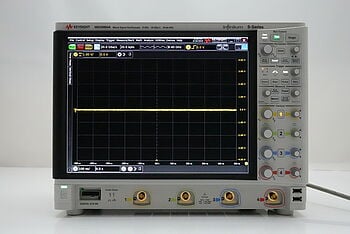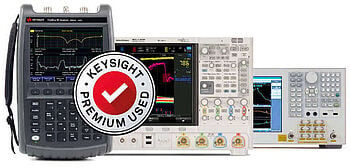- Introduction
- Understanding Vertical Offset
- The Critical Role of Vertical Offset in Waveform Viewing
- Unlocking Waveform Details
- Accommodating High Voltage Levels
- Enhancing Multiple Signal Analysis
- The Importance of Vertical Offset in Oscilloscopes
- Mastering the Use of Vertical Offset
- Potential Issues and Troubleshooting Tips
- Advanced Applications of Vertical Offset
- Pulse Width Modulated (PWM) Signals
- Power Quality Analysis
- Demodulating AM Signals
- Comparing Minute Differences
- Conclusion
- Whenever You’re Ready, Here Are 5 Ways We Can Help You
What if there was a simple tool within your oscilloscope that can dramatically improve your ability to analyze intricate waveform details? Vertical offset, an often overlooked feature, opens new dimensions of flexibility and capability in your oscilloscope. Let's uncover the potential of this powerful tool in signal analysis.
Buy Oscilloscopes at a Great Discount
Understanding Vertical Offset
Vertical offset is a feature that allows users to shift a waveform vertically on the oscilloscope's display without affecting the measurement scale.
The role of the vertical offset is as follows:
- Amplify small signals: By shifting the waveform off the zero level, users can use higher amplification (reduced volts/div) to view smaller details of the waveform.
- Observe signals with high absolute voltage levels: If a signal's DC level is beyond the range of the oscilloscope, the vertical offset allows you to adjust the mean signal level into the observable range.
| Key Takeaway |
|---|
| The vertical offset function in oscilloscopes is an invaluable tool that significantly enhances waveform visibility and interpretability, providing more detailed and precise analyses. Its application ranges from basic signal viewing to advanced scenarios such as PWM signal analysis, power quality studies, and digital signal processing, making it a versatile function essential for electrical engineers. |
The Critical Role of Vertical Offset in Waveform Viewing
Vertical offset's impact on the viewing and interpretation of waveforms is paramount. Its primary function—shifting the signal to any desired level—translates to significant advantages in waveform analysis. By manipulating the vertical offset, you gain the ability to scrutinize even the smallest details of a wavefrom leading to more comprehensive and precise results.
Unlocking Waveform Details
When dealing with complex or small-amplitude signals, every detail matters. A slight variation in waveform could indicate a crucial component behavior or system response. With vertical offset, you can "magnify" these small signals by shifting them off the zero level and then increasing the vertical scale (decreasing volts/div). This allows for a more detailed view of these small fluctuations, enabling a more in-depth analysis.
Accommodating High Voltage Levels
On the other hand, if your signal carries a high absolute voltage level—especially prevalent in power electronics—it could be challenging to view the signal within the oscilloscope's display range. This is where the vertical offset can work wonders by adjusting the mean signal level, effectively bringing the entire waveform into view. This comprehensive visibility facilitates an accurate interpretation of the waveform and its characteristics.
Enhancing Multiple Signal Analysis
When analyzing multiple waveforms simultaneously, the screen can get cluttered, making it difficult to distinguish one waveform from another. By using vertical offset, you can shift each signal vertically, effectively separating them on the display. This organized view allows for easier comparison and analysis of multiple signals, enhancing your ability to detect any potential signal anomalies or correlations.

The Importance of Vertical Offset in Oscilloscopes
Vertical offset plays a crucial role in the world of electronics testing and troubleshooting. Here are the three key reasons why it's an indispensable feature of oscilloscopes.
- Enhanced signal clarity: It allows you to remove the unwanted DC component, allowing you to focus solely on the signal's AC characteristics. This is particularly important when analyzing signals with a large DC offset, such as in power electronics.
- Better use of screen real estate: It lets you view multiple signals simultaneously without overlapping, improving the efficiency of your testing procedure.
- Amplification of small signals: It permits you to make small signals larger by adjusting the volts/div setting to a smaller value. This feature is useful when trying to detect small amplitude changes in a large DC signal.
Mastering the Use of Vertical Offset
Using the vertical offset in an oscilloscope is straightforward, yet it can significantly improve your signal analysis capabilities. Let's take a closer look at each step to better understand the process and its implications.
Step 1: Connect Your Signal
Before any waveform analysis can occur, you need to connect your oscilloscope to your device under test (DUT). Attach the test lead (usually a probe) to your oscilloscope and then connect it to your test point. This connection forms the vital link that enables the oscilloscope to capture and display the waveform from your DUT.
Step 2: Choose the Right Channel
Modern oscilloscopes offer multiple channels, each capable of receiving and displaying a different input signal. This multi-channel capability allows for concurrent viewing and analysis of several signals. Once your test lead is connected, you need to select the appropriate channel on the oscilloscope. This is the channel to which your test lead is connected, and it will display the waveform from your DUT.
Step 3: Adjust the Scale
The next step is to adjust the vertical scale (measured in volts/division) until your waveform fits well on the screen. This process is critical for obtaining an accurate and useful representation of your waveform. If your scale is too small, the waveform might appear flat, obscuring essential details. On the other hand, a scale that's too large might cause your waveform to exceed the screen's limits, potentially losing crucial information.
Step 4: Set the Offset
After the scale has been adjusted, you can then set the vertical offset. This feature shifts the waveform vertically, without changing the vertical scale, allowing you to center your waveform around any value. This positioning is particularly useful when you're dealing with signals that carry a large DC component or have a high average value, as it brings the entire waveform within the oscilloscope's range for detailed analysis.
Step 5: Analyze Your Signal
With your signal properly scaled and offset, you're now ready to delve into the waveform's details. You can zoom in to view small signal changes, allowing you to uncover even the slightest signal variations. These tiny details can hold critical information about your DUT, making this last step potentially the most informative part of your analysis.
Potential Issues and Troubleshooting Tips
While the vertical offset is a powerful tool, it's not without potential pitfalls. Here are some common issues and how to address them:
| Potential Issue | Troubleshooting Tips |
|---|---|
| Signal Clipping | If you notice flat tops or bottoms on your waveform (clipping), it may be due to a high vertical offset. Adjust your offset to bring the waveform within the oscilloscope's range. |
| Reduced Signal Clarity | If you lose details after removing the DC component, try using a lesser offset or reintroducing the DC component. |
| Unwanted Signal Shift | If the vertical offset seems to shift your waveform when it shouldn't, ensure you're not accidentally adjusting the vertical position instead of the offset. |
Advanced Applications of Vertical Offset
Vertical offset is not just limited to basic usage. It can also be used in more advanced signal analysis scenarios. Vertical offset is used in various applications, from unique signal types to complex measurement techniques and digital signal processing. This helps to achieve better and more insightful results.
Pulse Width Modulated (PWM) Signals
In the field of power electronics and digital communications, Pulse Width Modulated (PWM) signals are common. Here, the pulse width conveys information, and often, the signal carries a substantial DC offset. When analyzing PWM signals, the vertical offset can be used to shift the waveform, allowing you to focus on the pulse widths while keeping the oscilloscope settings at a range where the entire waveform is visible.
Power Quality Analysis
When conducting power quality analysis—like examining the harmonic content of an AC line voltage—the vertical offset plays a critical role. It allows for the observation and measurement of AC signals superimposed on high DC offset voltages. By using the vertical offset to shift and center the waveform, you can analyze the harmonic content without the signal exceeding the oscilloscope's range.
Demodulating AM Signals
While demodulating amplitude modulated (AM) signals, removing the DC component (done by setting an appropriate vertical offset) is an important first step. Once the DC component is removed, the signal can be processed and the original information extracted.
Comparing Minute Differences
In certain scenarios, you might need to compare the differences between two signals, where these differences might be minute. By using the vertical offset to align the two waveforms vertically, you can then zoom into the signals for a closer look, making it easier to spot tiny discrepancies.
Conclusion
Throughout this article, we've seen the remarkable role that the vertical offset function plays in an oscilloscope. This is about more than just shifting waveforms. It improves your ability to analyze and interpret signal details with extreme precision. This applies to various scenarios, such as basic signal viewing, analyzing PWM signals, conducting power quality analysis, and digital signal processing. It's clear that this powerful feature is more than a simple tool; it's a game-changer for electrical engineers.
But understanding the theory is just one part of the equation. Putting this knowledge into practice requires access to quality testing equipment. At Keysight, we provide a wide range of pre-owned, like-new, fully calibrated oscilloscopes, signal analyzers and network analyzers.
Not only will you get reliable and high-performance equipment, but you'll also enjoy significant savings. So why wait? Embrace the power of vertical offset and enhance your signal analysis capabilities today by exploring the comprehensive selection at Keysight's Used Equipment Store. Step into the world of advanced waveform analysis and uncover the details that matter the most.

Browse Oscilloscopes at a Great Discount
Whenever You’re Ready, Here Are 5 Ways We Can Help You
- Browse our Premium Used Oscilloscopes.
- Call tech support US: +1 800 829-4444
Press #, then 2. Hours: 7 am – 5 pm MT, Mon– Fri - Talk to our sales support team by clicking the icon (bottom right corner) on every offer page
- Create an account to get price alerts and access to exclusive waitlists.
- Talk to your account manager about your specific needs.

































































































